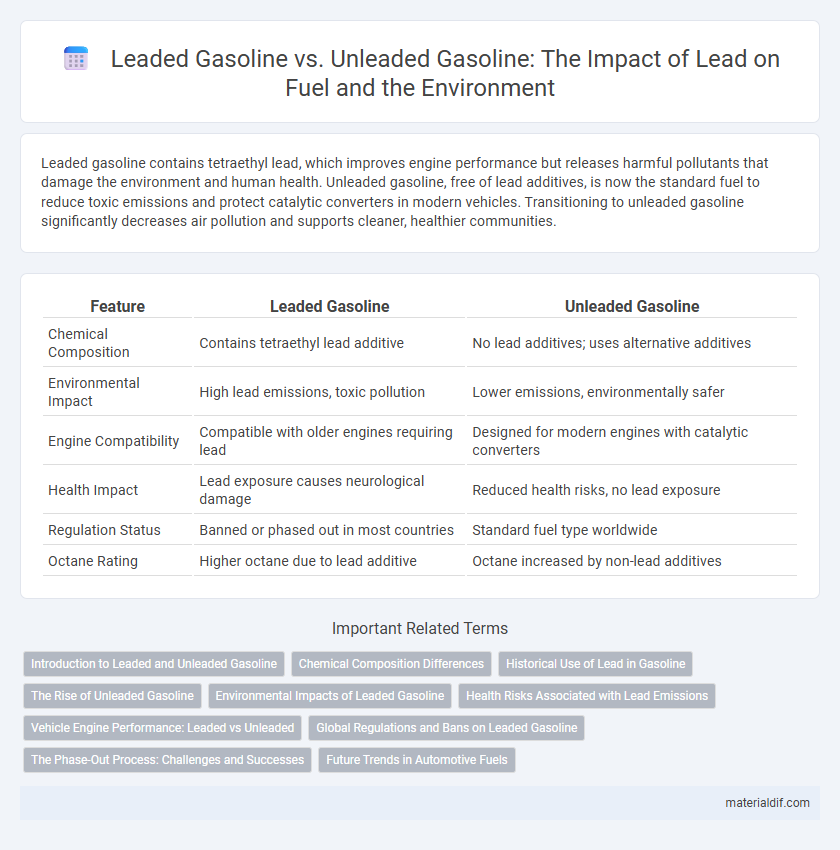Leaded gasoline contains tetraethyl lead, which improves engine performance but releases harmful pollutants that damage the environment and human health. Unleaded gasoline, free of lead additives, is now the standard fuel to reduce toxic emissions and protect catalytic converters in modern vehicles. Transitioning to unleaded gasoline significantly decreases air pollution and supports cleaner, healthier communities.
Table of Comparison
| Feature | Leaded Gasoline | Unleaded Gasoline |
|---|---|---|
| Chemical Composition | Contains tetraethyl lead additive | No lead additives; uses alternative additives |
| Environmental Impact | High lead emissions, toxic pollution | Lower emissions, environmentally safer |
| Engine Compatibility | Compatible with older engines requiring lead | Designed for modern engines with catalytic converters |
| Health Impact | Lead exposure causes neurological damage | Reduced health risks, no lead exposure |
| Regulation Status | Banned or phased out in most countries | Standard fuel type worldwide |
| Octane Rating | Higher octane due to lead additive | Octane increased by non-lead additives |
Introduction to Leaded and Unleaded Gasoline
Leaded gasoline contains tetraethyl lead, added to improve engine performance and reduce knocking, but poses significant health and environmental risks due to lead emissions. Unleaded gasoline eliminates these harmful additives, providing cleaner combustion and reducing lead pollution while maintaining engine efficiency. The global shift from leaded to unleaded gasoline reflects efforts to minimize toxic lead exposure and promote sustainable fuel standards.
Chemical Composition Differences
Leaded gasoline contains tetraethyl lead (TEL) compounds, which act as anti-knock agents by increasing the octane rating and reducing engine knocking, whereas unleaded gasoline relies on alternative additives such as MTBE or ethanol for octane enhancement. The chemical structure of leaded gasoline includes organolead compounds that deposit lead oxides in the engine, contributing to toxicity and environmental pollution. Unleaded gasoline's composition eliminates these toxic lead additives, thereby reducing harmful emissions and the accumulation of lead residues in combustion engines.
Historical Use of Lead in Gasoline
Lead was widely used in gasoline from the 1920s to the 1970s as tetraethyllead to enhance octane rating and engine performance. The harmful environmental and health effects of lead exposure prompted progressive regulations and the eventual phase-out of leaded gasoline starting in the 1970s. Unleaded gasoline became the standard fuel globally due to stricter emission standards and advancements in engine technology, reducing atmospheric lead contamination.
The Rise of Unleaded Gasoline
The rise of unleaded gasoline was driven by growing environmental and public health concerns over the toxic effects of lead additives in fuel, which caused air pollution and neurological damage. Regulatory measures such as the U.S. Clean Air Act and global policies mandated the phase-out of leaded gasoline, accelerating the adoption of unleaded alternatives. Advances in catalytic converter technology further incentivized the shift, as unleaded gasoline is essential for optimal emission control and engine performance.
Environmental Impacts of Leaded Gasoline
Leaded gasoline releases toxic lead particles into the atmosphere, causing air and soil contamination that poses serious health risks to humans and wildlife. Prolonged exposure to lead emissions has been linked to neurological damage, developmental delays in children, and increased cardiovascular diseases. The phase-out of leaded gasoline has significantly reduced environmental lead pollution, improving public health and ecosystem quality worldwide.
Health Risks Associated with Lead Emissions
Lead emissions from leaded gasoline significantly increase the risk of neurological damage, especially in children, causing cognitive impairments and developmental delays. Unleaded gasoline reduces these health hazards by eliminating lead exposure, which is linked to cardiovascular problems, kidney damage, and behavioral disorders in adults. Phasing out leaded gasoline has proven critical in lowering atmospheric lead concentrations and improving public health outcomes globally.
Vehicle Engine Performance: Leaded vs Unleaded
Leaded gasoline enhances engine performance by increasing octane levels, which reduces knocking and allows higher compression ratios, resulting in more power and efficiency. Unleaded gasoline requires advanced engine designs with hardened valve seats to prevent premature wear, but offers cleaner combustion and lower emissions. Modern engines optimized for unleaded fuel maintain performance while meeting stricter environmental standards.
Global Regulations and Bans on Leaded Gasoline
Global regulations have progressively eliminated leaded gasoline due to its severe environmental and health impacts, with over 100 countries enforcing full bans as part of the United Nations' efforts to reduce lead poisoning. The Global Alliance to Eliminate Lead Paint spearheads international initiatives, while the phase-out aligns with World Health Organization guidelines emphasizing the reduction of airborne lead emissions. Unleaded gasoline has become the global standard fuel, supported by stringent policies from organizations like the Environmental Protection Agency (EPA) and the European Union to mitigate lead contamination worldwide.
The Phase-Out Process: Challenges and Successes
The phase-out of leaded gasoline faced significant challenges including retrofitting existing engines and overcoming resistance from industries reliant on tetraethyl lead additives. Successes were marked by global regulatory measures, widespread public health improvements, and the development of unleaded gasoline-compatible engine technologies. Persistent international collaboration enabled most countries to eliminate leaded gasoline, drastically reducing airborne lead pollution and associated health risks.
Future Trends in Automotive Fuels
The future of automotive fuels is rapidly shifting towards unleaded gasoline due to stringent environmental regulations targeting lead emissions that cause neurotoxicity and air pollution. Advances in fuel formulations and catalytic converter technologies have made unleaded gasoline the industry standard, promoting cleaner combustion and improved engine efficiency. Emerging trends also include the integration of biofuels and synthetic additives to further reduce the carbon footprint of conventional unleaded fuels.
Leaded gasoline vs Unleaded gasoline Infographic

 materialdif.com
materialdif.com